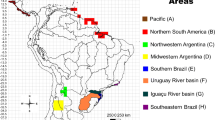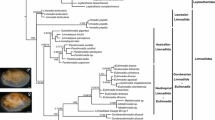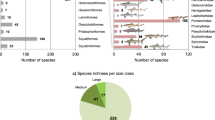Abstract
Biogeographic investigations of Gondwanan mesic Australian fauna are scarce. The burrowing clade of Australian freshwater crayfish represent an ideal group to provide biogeographic inferences, due to their extensive distribution across the continent and their presumed ancient origin. This study tested the competing hypotheses of a ‘early’ versus ‘late’ origin of this clade, coinciding with the early or late fragmentation of Gondwana, respectively. The biogeographic history of this group was investigated through: (a) examination of the phylogenetic relationships between the seven extant taxon groups; (b) reconstruction of four species trees, each using a different calibration method; and (c) reconstruction of ancestral ranges and correlation of estimated dispersal and vicariance events with historical geological data to propose plausible mechanisms responsible for driving diversification. The phylogenetic relationships between the taxon groups were generally well supported (although some uncertainty exists for the oldest genera), and all calibration methods produced concordant results. The hypothesis that the clade arose during the early fragmentation of Gondwana in southern Australia is supported. Divergence between the extant taxa likely resulted from a combination of both short- and long-distance dispersal events (often followed by later vicariance), coincident with phases of sea level oscillation and changing climate continuing into the Eocene.






Similar content being viewed by others
Data availability statement
The data that supports the findings of this study are available in the ‘Online Resources’ for this article.
References
Austin, C. M., T. T. Nguyen, M. M. Meewan & D. R. Jerry, 2003. The taxonomy and phylogeny of the ‘Cherax destructor’ complex (Decapoda: Parastacidae) examined using mitochondrial 16S sequences. Australian Journal of Zoology 51: 99–110.
Blakey, R. C., 2008. Gondwana paleogeography from assembly to breakup – a 500 m.y. odyssey. In Fielding, C. R., T. D. Frank & J. L. Isbell (eds), Resolving the Late Paleozoic Ice Age in Time and Space: Geological Society of America Special Paper 441. The Geological Society of America, Boulder: 1–28.
Buhay, J. E. & K. A. Crandall, 2005. Subterranean phylogeography of freshwater crayfishes shows extensive gene flow and surprisingly large population sizes. Molecular Ecology 14: 4259–4273.
Buhay, J. E., G. Moni, N. Mann & K. A. Crandall, 2007. Molecular taxonomy in the dark: evolutionary history, phylogeography, and diversity of cave crayfish in the subgenus Aviticambarus, genus Cambarus. Molecular Phylogenetics and Evolution 42: 435–448.
Burnham, Q., 2014. Systematics and biogeography of the Australian burrowing freshwater crayfish genus Engaewa Riek (Decapoda: Parastacidae). Unpublished Ph.D. Thesis., Edith Cowan University, Australia.
Byrne, M., D. A. Steane, L. Joseph, D. K. Yeates, G. J. Jordan, D. Crayn, K. Aplin, D. J. Cantrill, L. G. Cook, M. D. Crisp, J. S. Keogh, J. Melville, C. Moritz, N. Porch, J. M. K. Sniderman, P. Sunnucks & P. H. Weston, 2011. Decline of a biome: evolution, contraction, fragmentation, extinction and invasion of the Australian mesic zone biota. Journal of Biogeography 38: 1635–1656.
Crandall, K. A. & J. E. Buhay, 2008. Global diversity of crayfish (Astacidae, Cambaridae, and Parastacidae – Decapoda) in freshwater. Hydrobiologia 595: 295–301.
Crandall, K. A., J. W. Fetzner, S. H. Lawler, M. Kinnersley & C. M. Austin, 1999. Phylogenetic relationships among the Australian and New Zealand genera of freshwater crayfishes (Decapoda: Parastacidae). Australian Journal of Zoology 47(2): 199–214.
Crandall, K. A., D. J. Harris & J. W. Fetzner, 2000. The monophyletic origin of freshwater crayfish estimated from nuclear and mitochondrial DNA sequences. Proceedings of the Royal Society London B 267(1453): 1679–1686.
Dawkins, K. L., J. M. Furse, C. H. Wild & J. M. Hughes, 2017. A novel genus and cryptic species harboured within the monotypic freshwater crayfish genus Tenuibranchiurus Riek, 1951 (Decapoda: Parastacidae). PeerJ 5: e3310.
Drummond, A. J. & A. Rambaut, 2007. BEAST: Bayesian evolutionary analysis by sampling trees. BMC Evolutionary Biology 7: 214–222.
Drummond, A. J., M. A. Suchard, D. Xie & A. Rambaut, 2012. Bayesian phylogenetics with BEAUti and the BEAST 1.7. Molecular Biology and Evolution 29: 1969–1973.
Fawcett, P. J., E. J. Barron, V. D. Robinson & B. J. Katz, 1994. The climatic evolution of India and Australia from the late permian to mid-Jurrasic: a comparison of climate model results with the geological record. In Klein, G. O. (ed.), Pangea: Paleoclimate, Tectonics, and Sedimentation During Accretion, Zenith, and Breakup of a Supercontinent. The Geological Society of America Inc, Boulder: 139–158.
Fetzner, J. W. & K. A. Crandall, 2003. Linear habitats and the nested clade analysis: an empirical evaluation of geographic versus river distances using an Ozark crayfish (Decapoda: Cambaridae). Evolution 57(9): 2101–2118.
Frakes, L. A., 1997. Grossplots: a method for estimating the temperature state of the earth and of Australia, Cretaceous to Middle Miocene. Australian Journal of Botany 45: 359–372.
Frakes, L. A., D. Burger, M. Apthorpe, J. Wiseman, M. Dettmann, N. Alley, R. Flint, D. Gravestock, N. Ludbrook, J. Backhouse, S. Skwarko, V. Scheibnerova, A. McMinn, P. S. Moore, B. R. Bolton, J. G. Douglas, R. Christ, M. Wade, R. E. Molnar, B. McGowran, B. E. Balme & R. A. Day, 1987. Australian cretaceous shorelines, stage by stage. Palaeogeography, Palaeoclimatology, Palaeoecology 59: 31–48.
Hansen, B. & A. M. M. Richardson, 2002. Geographic ranges, sympatry and the influence of environmental factors on the distribution of species of an endemic Tasmanian freshwater crayfish. Invertebrate Systematics 16: 621–629.
Haq, B. Q., J. Hardenbol & P. R. Vail, 1987. Chronology of fluctuating sea levels since the triassic. Science 235: 1156–1167.
Harris, P., A. Heap, V. Passlow, L. Sbaffi, M. Fellows, R. Porter-Smith, C. Buchanon & J. Daniell, 2005. Geomorphic Features of the Continental Margin of Australia. Geoscience Australia, Record 2003/30.
Hill, R. S., 2004. Origins of the southeastern Australian vegetation. Philosophical Transactions of the Royal Society of London B 359: 1537–1549.
Holthius, L. B., 1986. The freshwater crayfish of New Guinea. Freshwater Crayfish 6: 48–58.
Horwitz, P., 1988. Sea-level fluctuations and the distributions of some freshwater crayfishes of the genus Engaeus (Decapoda; Parastacidae) in the Bass Strait area. Australian Journal of Marine and Freshwater Research 39: 497–502.
Hughes, J. M. & M. J. Hillyer, 2003. Patterns of connectivity among populations of Cherax destructor (Decapoda: Parastacidae) in western Queensland, Australia. Marine and Freshwater Research 54: 587–596.
Hughes, J. M., J. A. Huey & D. J. Schmidt, 2013. Is realised connectivity among populations of aquatic fauna predictable from potential connectivity? Freshwater Biology 58: 951–966.
Hurwood, D. A. & J. M. Hughes, 1998. Phylogeography of the freshwater fish, Mogurnda adspersa, in streams of northeastern Queensland, Australia: evidence for altered drainage patterns. Molecular Ecology 7: 1507–1517.
Jones, J. G. & J. J. Veevers, 1982. A Cainozoic history of Australia’s southeast highlands. Journal Geological Society of Australia 29(1–2): 1–12.
Katoh, K. & D. M. Standley, 2013. MAFFT Multiple Sequence Alignment Software Version 7: improvements in performance and usability. Molecular Biology and Evolution 30(4): 772–780.
Koizumi, I., N. Usio, T. Kawai, N. Azuma & R. Masuda, 2012. Loss of genetic diversity means loss of geological information: the endangered japanese crayfish exhibits remarkable historical footprints. PLoS ONE 7(3): e33986.
Larson, E. R., M. Castelin, B. W. Williams, J. D. Olden & C. L. Abbott, 2016. Phylogenetic species delimitation for crayfishes of the genus Pacifastacus. PeerJ 4: e1915.
Martin, H. A., 2006. Cenozoic climatic change and the development of the arid vegetation in Australia. Journal of Arid Environments 66(3): 533–536.
Martin, A. J., T. H. Rich, G. C. B. Poore, M. B. Schultz, C. M. Austin, L. Kool & P. Vickers-Rich, 2008. Fossil evidence in Australia for oldest known freshwater crayfish of Gondwana. Gondwana Research 14: 187–296.
Miller, M. A., W. Pfeiffer & T. Schwartz, 2010. Creating the CIPRES Science Gateway for Inference of Large Phylogenetic Trees. New Orleans, LA.
Mills, B. J., N. M. Morrissey & J. V. Huner, 1994. Cultivation of freshwater crayfish in Australia. In Huner, J. V. (ed.), Freshwater Crayfish Aquaculture in North America, Europe and Australia. Food Product Press, New York: 312 p.
Munasinghe, D. H. N., C. P. Burridge & C. M. Austin, 2004. Molecular phylogeny and zoogeography of the freshwater crayfish genus Cherax Erichson (Decapoda: Parastacidae) in Australia. Biological Journal of the Linnean Society 81: 553–563.
Nguyen, T. T., C. M. Austin, M. M. Meewan, M. B. Schultz & D. R. Jerry, 2004. Phylogeography of the freshwater crayfish Cherax destructor Clark (Parastacidae) in inland Australia: historical fragmentation and recent range expansion. Biological Journal of the Linnean Society 83: 539–550.
Owen, C. L., H. Bracken-Grissom, D. Stern & K. A. Crandall, 2015. A synthetic phylogeny of freshwater crayfish: insights for conservation. Philosophical Transactions of the Royal Society B 370: 20140009.
Ponniah, M. & J. M. Hughes, 2004. The evolution of Queensland spiny mountain crayfish of the genus Euastacus. I. Testing vicariance and dispersal with interspecific mitochondrial DNA. Evolution 58(5): 1073–1085.
Ponniah, M. & J. M. Hughes, 2006. The evolution of Queensland spiny mountain crayfish of the genus Euastacus. II. Investigating simultaneous vicariance with intraspecific genetic data. Marine and Freshwater Research 57: 349–362.
Porter, M. L., M. Perez-Losada & K. A. Crandall, 2005. Model-based multi-locus estimation of decapod phylogeny and divergence times. Molecular Phylogenetics and Evolution 37: 355–369.
Posada, D., 2008. jModelTest: phylogenetic model averaging. Molecular Biology and Evolution 25: 1253–1256.
Quilty, P. G., 1984. Mesozoic and Cenozoic history of Australia as it affects the Australian biota. In Cogger, H. G. & E. E. Cameron (eds), Arid Australia. Australian Museum, Sydney: 7–55.
Quilty, P. G., 1994. The backgroud: 144 million years of Australian palaeoclimate and palaegeography. In Hill, R. S. (ed.), History of the Australian Vegetation: Cretaceous to Recent. Cambridge University Press, Cambridge: 14–43.
Rambaut, A., 2012. Figtree version 1.4.0. [available on internet at http://tree.bio.ed.ac.uk/software/figtree/.In].
Rambaut, A., A. J. Drummond, D. Xie, G. Baele & M. A. Suchard, 2018. Posterior summarisation in Bayesian phylogenetics using Tracer 1.7. Systematic Biology 67: 901–904.
Riek, E. F., 1969. The Australian freshwater crayfish (Crustacea: Decapoda: Parastacidae), with descriptions of new species. Australian Journal of Zoology 17: 855–918.
Ronquist, F., 2004. Bayesian inference of character evolution. TRENDS in Ecology & Evolution 19(9): 475–481.
Ronquist, F., M. Teslenko, P. van der Mark, D. L. Ayres, A. Darling, S. Höhna, B. Larget, L. Liu, M. A. Suchard & J. P. Huelsenbeck, 2012. MrBayes 3.2: efficient Bayesian phylogenetic inference and model choice across a large model space. Systematic Biology 61(3): 539–542.
Schubart, C. D., R. Diesel & S. B. Hedges, 1998. Rapid evolution to terrestrial life in Jamaican crabs. Nature 393: 363–365.
Schultz, M. B., S. A. Smith, A. M. M. Richardson, P. Horwitz, K. A. Crandall & C. M. Austin, 2007. Cryptic diversity in Engaeus Erichson, Geocharax Clark and Gramastacus Riek (Decapoda:Parastacidae) revealed by mitochondrial 16S rDNA sequences. Invertebrate Systematics 21(6): 569–587.
Schultz, M. B., S. A. Smith, P. Horwitz, A. M. M. Richardson, K. A. Crandall & C. M. Austin, 2009. Evolution underground: a molecular phylogenetic investigation of Australian burrowing freshwater crayfish (Decapoda: Parastacidae) with particular focus on Engaeus Erichson. Molecular Phylogenetics and Evolution 50(3): 580–598.
Sinclair, E. A., J. W. Fetzner, J. Buhay & K. A. Crandall, 2004. Proposal to complete a phylogenetic taxonomy and systematic revision for freshwater crayfish (Astacidea). Freshwater Crayfish 14: 21–29.
Sluijs, A., P. K. Bijl, S. Schouten, U. Rohl, G.-J. Reichart & H. Brinkhuis, 2011. Southern ocean warming, sea level and hydrological change during the Paleocene-Eocene thermal maximum. Climate of the Past 7: 47–61.
Stamatakis, A., 2006. RAxML-VI-HPC: maximum likelihood-based phylogenetic analyses with thousands of taxa and mixed models. Bioinformatics 22: 2688–2690.
Stamatakis, A., P. Hoover & J. Rougemont, 2008. A fast bootstrapping algorithm for the RAxML Web-Servers. Systematic Biology 57(5): 758–771.
Stillman, J. H. & C. A. Reeb, 2001. Molecular phylogeny of eastern Pacific porcelain crabs, genera Petrolisthes and Pachycheles, based on the mtDNA 16S rDNA sequence: phylogeographic and systematic implications. Molecular Phylogenetics and Evolution 19(2): 236–245.
Stöver, B. C. & K. F. Müller, 2010. TreeGraph 2: combining and visualizing evidence from different phylogenetic analyses. BMC Bioinformatics 11: Article 7. https://doi.org/10.1186/1471-2105-11-7.
Sturmbauer, C., J. S. Leninton & J. Christy, 1996. Molecular phylogeny analysis of fiddler crabs: test of the hypothesis of increasing behavioral complexity in evolution. Proceedings of the National Academy of Sciences USA 93: 10855–10857.
Swofford, D. L., 2003. PAUP*. Phylogenetic Analysis Using Parsimony (*and other methods). Version 4. Sinauer Associates, Sunderland, Massachusetts.
Thacker, C. E., P. J. Unmack, L. Matsui & N. Rifenbark, 2007. Comparative phylogeography of five sympatric Hypseleotris species (Teleostei: Eleotridae) in south-eastern Australia reveals a complex pattern of drainage basin exchanges with little congruence across species. Journal of Biogeography 34: 1518–1533.
Toon, A., M. Perez-Losoda, C. E. Schweitzer, R. W. Feldman, M. Carlson & K. A. Crandall, 2010. Gondwanan radiation of the Southern Hemisphere crayfishes (Decapoda: Parastacidae): evidence from fossils and molecules. Journal of Biogeography 37: 2275–2290.
Twidale, C. R., 1994. Gondwanan (Late Jurassic and Cretaceous) palaeosurfaces of the Australian craton. Palaeogeography, Palaeoclimatology, Palaeoecology 112: 157–186.
Unmack, P. J., 2001. Biogeography of Australian freshwater fishes. Journal of Biogeography 28: 1053–1089.
Veevers, J. J., 1991. Mid-Cretaceous tectonic climax, Late Cretaceous recovery, and Cainozoic relaxation in the Australian region. In Williams, M. A. J., P. De Deckker & A. P. Kershaw (eds) The Cainozoic in Australia: A Re-appraisal of the Evidence Geological Society of Australia, Sydney: 1–14.
Veevers, J. J., 2004. Gondwanaland from 650–500 Ma assembly through 320 Ma merger in Pangea to 185–100 Ma breakup: supercontinental tectonics via stratigraphy and radiometric dating. Earth-Science Reviews 68: 1–132.
Veevers, J. J., 2006. Updated Gondwana (Permian–Cretaceous) earth history of Australia. Gondwana Research 9: 231–260.
Xia, X., 2013. DAMBE5: a comprehensive software package for data analysis in molecular biology and evolution. Molecular Biology and Evolution. https://doi.org/10.1093/molbev/mst064.
Yu, Y., A. J. Harris & X.-J. He, 2013. RASP (Reconstruct Ancestral State in Phylogenies) 2.1 beta [available on internet at http://mnh.scu.edu.cn/soft/blog/RASP].
Yu, Y., A. J. Harris & X.-J. He, 2010. S-DIVA (statistical dispersal-vicariance analysis): a tool for inferring biogeographic histories. Molecular Phylogenetics and Evolution 56(2): 848–850.
Acknowledgements
Dr Andrew Bentley provided invaluable advice regarding species tree reconstructions. Dr Quinton Burnham provided helpful comments that improved the manuscript. Prof Clyde Wild provided advice during earlier stages of this project. This study was part of a project funded by an Australian Postgraduate Award. Australian Rivers Institute at Griffith University provided additional funding and facilities.
Author information
Authors and Affiliations
Corresponding author
Additional information
Handling editor: Diego Fontaneto.
Publisher's Note
Springer Nature remains neutral with regard to jurisdictional claims in published maps and institutional affiliations.
Electronic supplementary material
Below is the link to the electronic supplementary material.
Rights and permissions
About this article
Cite this article
Dawkins, K.L., Furse, J.M. & Hughes, J.M. The biogeographic history of the relictual Gondwanan lineage of Australian burrowing crayfish. Hydrobiologia 848, 403–420 (2021). https://doi.org/10.1007/s10750-020-04448-y
Received:
Revised:
Accepted:
Published:
Issue Date:
DOI: https://doi.org/10.1007/s10750-020-04448-y




